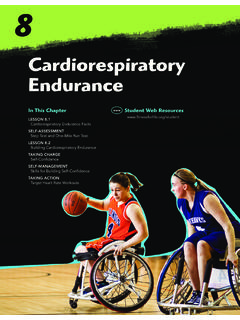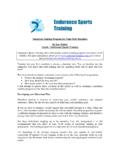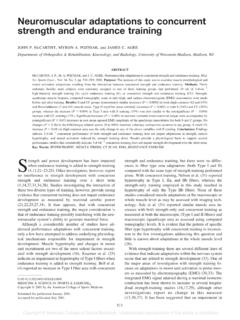Transcription of STRAPPING THE ENDURANCE HORSE - AERA
1 STRAPPING THE ENDURANCE HORSE . Notes by Leanne LeClaire BVSc The Day Before (Usually Saturday). - fill and set out water buckets - lay out halter, sponges, stethoscope, towels and rugs - have molasses handy - set up water heater On Ride Morning (Usually early Sunday Morning). - light hot water heater (if you have no strapper ). - wrap hay in wet hessian bag - check that all your STRAPPING equipment is handy On return to base at end of first leg - look at how people are dressed or ask your strapper if it is warm, cool or cold? Do not rely on how you feel - you will normally feel hot! 1. If Cool/Cold - unsaddle, halter on, weigh-in - rug over hindquarters, take heart rate - allow to drink water with chill taken off (offer both molasses and plain water ). - wipe down with damp sponge - saddle area - between hind legs - legs - under tail and belly - areas where tack is in contact - around head - rug HORSE depending on conditions - light rug/towel if cool - heavy rug if cold/windy - waterproof if raining and cold - offer dampened hay - walk around gently allowing HORSE to pick at grass - continually monitor horses heart rate and skin temperature and adjust accordingly 2.
2 If Hot - unsaddle, halter on, weigh-in - take heart rate - allow to drink water with chill taken off (offer both molasses and plain water ). - sponge with water with chill taken off first then hose if available or sponge with copious water gradually using cooler water - sponge or wash and then scrape off water quickly (water on a hot HORSE quickly heats up and insulates the HORSE without cooling it down. Once scraped off evaporative cooling can take place). - light rug/towel over hindquarters if HORSE feels cool to touch - avoid cool water over rump and loins, some horses may stiffen up in this area - offer dampened hay - walk around gently allowing HORSE to pick at grass - continually monitor horses heart rate and skin temperature and wash and walk again where required Wash and Walk Technique - horses ridden hard anaerobically produce lactic acid as a waste product in muscles - this process continues after a HORSE stops exercising - if the HORSE is standing still the lactic acid builds up in the muscles - when the HORSE moves again the muscles push lactic acid into the blood which causes the heart rate to increase - as a result the heart rate may have dropped in camp but while walking to vetting the circulating lactic acid causes the heart rate to increase - important to wash and scrape then walk slowly for several minutes then repeat Urinating - drops heart rate through heat loss and reducing anxiety - encourage urinating by walking
3 In long grass - check colour as it indicates hydration status - clear is ideal - yellow indicates slight dehydration - dark yellow indicates severe dehydration - red/brown (coffee colour ) indicates muscle damage ( see vet ). Eating - will put heart rate up a few beats - better to allow them to pick at hay/grass than worry about increasing heart rate, especially a novice HORSE - if heart rate is that borderline the HORSE may have been overridden - eating helps to relax the HORSE and promote gut sounds - avoid grain and electrolytes until after vetting Electrolytes - only give if the HORSE is drinking well - electrolytes when a HORSE is not drinking will draw fluids into the gut and further dehydrate the HORSE - the taste of electrolytes can put horses off eating / drinking - build up levels before and after the ride Heart Rate - the heart rate recovery is more important than the arrival heart rate - 100 on arrival recovering to 60 in 15 minutes is better than 60 on arrival and still 60 in 15 minutes - lack of recovery is a sign of stress - if the heart rate drops well and all other parameters are good you can leave the HORSE alone to relax and walk him slowly allowing him to pick and drink Other Parameters - you should
4 Familiarise yourself with as many of the metabolic parameters as possible for your HORSE especially those dealing with hydration such as mucous membranes, skin recoil, gut sounds - take them at home regularly so you know what is normal, and use these to evaluate your HORSE 's recovery, this will also help your HORSE get used to vetting procedures Vetting - walk over to vetting area 5 minutes before your time slip indicates you are due - do not be late ! - if sunny wait in the shade and continue to walk your HORSE slowly - enter the TPR bay 1 or 2 minutes before you are due - leave the HORSE alone while he is being TPR'd, stand quietly with your HORSE and pay attention to your HORSE - if there is a delay from the TPR to the vet, walk your HORSE slowly to keep his muscles warm and prevent stiffening up After Vetting - feed, water and rug as necessary - electrolytes if drinking well - leave HORSE to rest and recover Rider - replace your own fluids and electrolytes - make sure you eat ( you will need your energy ).
5 - looking after your HORSE includes looking after yourself. - a tired, dehydrated rider is a burden for a hors






